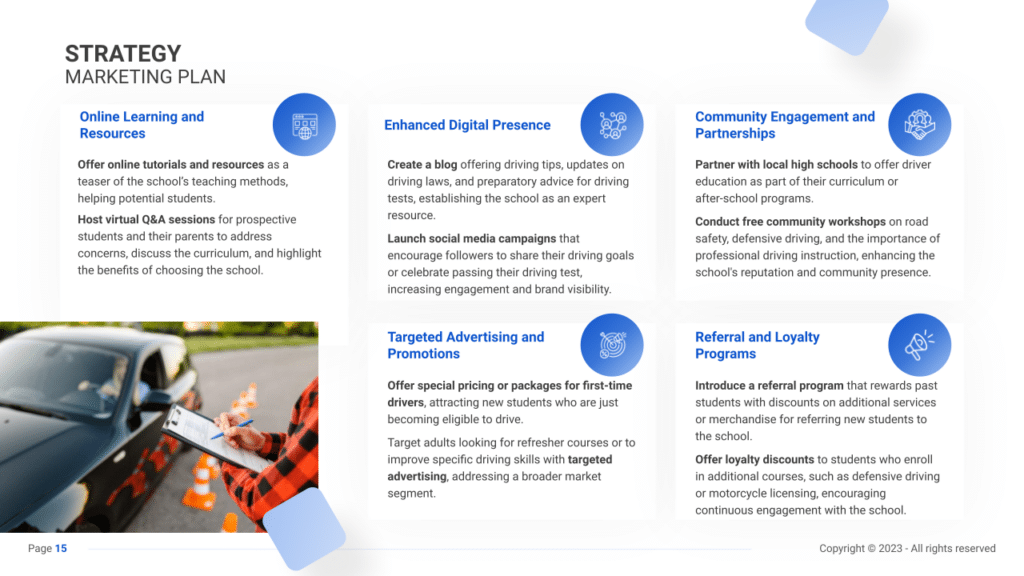Driving School Business Plan Template & PDF Example

Creating a comprehensive business plan is crucial for launching and running a successful driving school business. This plan serves as your roadmap, detailing your vision, operational strategies, and financial plan. It helps establish your driving school business’s identity, navigate the competitive market, and secure funding for growth.
This article not only breaks down the critical components of a driving school business plan, but also provides an example of a business plan to help you craft your own.
Whether you’re an experienced entrepreneur or new to the service industry, this guide, complete with a business plan example, lays the groundwork for turning your driving school business concept into reality. Let’s dive in!
The Plan
Our driving school business plan is carefully crafted to include all critical aspects needed for a complete and strategic outline. It details the school’s operational procedures, marketing strategies, market conditions, competition, management team, and financial forecasts.
- Executive Summary: Offers a snapshot of the driving school’s business idea, market evaluation, management team, and financial strategy.
- Business Overview: Provides comprehensive information on what your driving school delivers and its operational framework:
- School & Location: Describes the driving school’s facilities, training vehicles, and why its location benefits potential students.
- Courses & Pricing: Enumerates the driving courses offered, including beginner to advanced driving lessons, and the pricing model.
- Market Overview: Delves into the driving education sector, identifying competition and how your school distinguishes itself:
- Key Stats: Presents industry size, growth patterns, and pertinent statistics for the driving school market.
- Key Trends: Points out recent trends impacting the driving education field, such as online learning and simulator training.
- Key Competitors: Evaluates major competitors in the vicinity and how your driving school offers a unique value proposition.
- Strategy: Lays out how the driving school plans to secure growth and draw in students:
- SWOT: Analysis of strengths, weaknesses, opportunities, and threats.
- Marketing Plan: Tactics for attracting and keeping students, emphasizing digital marketing, community partnerships, and special programs.
- Timeline: Principal milestones and goals from the inception through the first year of operations.
- Management: Details on the individuals running the driving school and their respective roles.
- Financial Plan: Forecasts the driving school’s financial performance over 5 years, including income streams, profit margins, and anticipated costs.

Executive Summary
The Executive Summary introduces your driving school’s business plan, offering a concise overview of your school and its services. It should detail your market positioning, the range of driving instruction and related services you offer, its location, size, and an outline of day-to-day operations.
This section should also explore how your driving school will integrate into the local market, including the number of direct competitors within the area, identifying who they are, along with your school’s unique selling points that differentiate it from these competitors.
Furthermore, you should include information about the management and co-founding team, detailing their roles and contributions to the school’s success.
Additionally, a summary of your financial projections, including revenue and profits over the next five years, should be presented here to provide a clear picture of your driving school’s financial plan.
Driving School Business Plan Executive Summary Example


Business Overview
In the business overview of your executive summary, provide concise information about your driving school. Include the school’s name, the types of driving classes offered, the facilities and learning resources you provide, the expertise of your instructors, and your school’s location.
Detailing these aspects introduces your business and highlights its unique selling points (USPs), such as specialized classes, advanced learning technologies like driving simulators, or a strategic location. Your USP should capture the attention of your audience and showcase the unique value your driving school brings to the market.
Example:
“Driving Excellence School,” located in the heart of Downtown Metroville, offers a comprehensive range of driving classes, from Class D to CDL certifications and motorcycle licenses. With modern classrooms, a state-of-the-art driving simulator, and experienced instructors, our school stands out for its immersive learning experience and flexible class schedules, making it accessible and appealing to students of all ages.
Market Overview
This section should provide an overview of the driving school industry, including market size, growth trends, and key dynamics. Discuss trends such as the shift towards online education, the use of advanced simulators in training, and the growing emphasis on defensive driving courses.
Also, address the competitive landscape, identifying your main competitors and explaining how your driving school differentiates itself, whether through unique course offerings, advanced training methods, or competitive pricing.
Example:
The US driving school market, valued at $1.8 billion, is evolving with technology and changing regulations. “Driving Excellence School” is at the forefront of adopting online driver’s education and advanced simulators, offering a competitive edge in a market with diverse competitors within a 20-mile radius. Our focus on defensive driving and partnerships with insurance companies for course discounts further sets us apart.
Management Team
Highlight the qualifications, experiences, and roles of your key management team members. This section should illustrate the depth of expertise and leadership guiding your driving school.
Example:
Led by co-founders John Doe and Jane Smith, “Driving Excellence School” benefits from John’s extensive experience in driver education and Jane’s expertise in business management. Together, they ensure high instructional standards and a customer-focused approach, positioning the school for success.
Financial Plan
Summarize your financial objectives and forecasts, including revenue targets and profit margins, to provide a clear picture of your driving school’s financial outlook.
Example:
“Driving Excellence School” aims to achieve $1.4 million in annual revenue by 2028, with a 12% EBITDA margin. Our financial strategy is centered around expanding our class offerings, investing in advanced training technologies, and increasing market outreach, driving growth while maintaining a commitment to quality education and safety.
Business Overview
For a Driving School, the Business Overview section can be concisely divided into 2 main slides:
Courses & Pricing
Detail the variety of driving instruction courses offered, from beginner to advanced driving skills, defensive driving, and specialized courses like winter or night driving.
Outline your pricing strategy, ensuring it reflects the value and quality of instruction provided and matches the market you’re targeting. Highlight any packages, membership deals, or loyalty programs that provide added value to your students, encouraging repeat business and customer referrals.
School & Location
Briefly describe the driving school’s physical environment, emphasizing its facilities, such as classrooms equipped with modern teaching aids and a dedicated driving practice area.
Mention the school’s location, highlighting its accessibility and the convenience it offers to students, such as proximity to public transportation or ease of parking. Explain why this location is advantageous in attracting your target clientele, perhaps due to its closeness to high schools, colleges, or residential areas.


Market Overview

Industry Size & Growth
Begin with an analysis of the driving education industry, focusing on its size and potential for growth to understand market opportunities.
Key Market Trends
Discuss trends such as the demand for specialized driving courses, technology in education like simulators, and a focus on safety and eco-friendly driving.
Competitive Landscape
A competitive analysis is not just a tool for gauging the position of your driving school in the market and its key competitors; it’s also a fundamental component of your business plan.
This analysis helps in identifying your driving school’s unique selling points, essential for differentiating your business in a competitive market.
In addition, the competitive analysis is integral in laying a solid foundation for your business plan. By examining various operational aspects of your competitors, you gain valuable information that ensures your business plan is robust, informed, and tailored to succeed in the current market environment.
Identifying Your Competitors in the Driving School Industry
The initial step towards understanding your market position involves identifying your competitors. Start by listing local driving schools and training centers. For instance, if your driving school specializes in motorcycle training, your direct competitors include nearby schools offering similar courses, as well as larger training centers that provide a wide range of driving lessons. It’s also important to consider indirect competitors, such as online driving courses or mobile apps that offer driving theory training.
Utilize online resources like Google Maps to understand the geographical distribution of competitors. Platforms like Yelp and TripAdvisor can offer customer reviews and ratings, shedding light on the strengths and weaknesses of your competitors. For instance, if multiple reviews praise the comprehensive curriculum and patient instructors at “Safe Wheels Driving School,” these are significant strengths of that competitor.

Driving School Competitors’ Strategies
When analyzing your competitors’ strategies, consider several aspects:
- Course Offerings: Evaluate their range of driving courses. If “Eco Drive Academy” is becoming popular for its electric vehicle training programs, it might indicate a market trend towards eco-friendly driving.
- Training Methods: Look into the training methods and vehicles used. A school like “Classic Drive” that provides lessons in vintage cars might attract a niche market compared to a school like “Tech-Drive” known for using the latest vehicle technologies.
- Pricing Strategy: Assess how your prices compare to those of your competitors. Are your courses priced similarly to “Budget Driver School,” or are they more in line with the premium packages offered by “Elite Driving Academy”?
- Marketing Techniques: Examine how competitors market their services. Do they have a significant online presence, or do they focus more on local advertising and community engagement?
- Customer Experience: Evaluate the overall customer experience. For example, “Friendly Drive School” might be known for its supportive and encouraging teaching style, contributing to a better learning environment.
- Operational Efficiency: Observe if competitors are leveraging technology or innovative teaching methods to enhance efficiency, such as “DriveStream Academy” with its interactive online learning modules.
What’s Your Driving School’s Value Proposition?
Reflect on what makes your driving school stand out. Perhaps you offer specialized defensive driving courses, or maybe your school is the only one in the area with a simulator for safe, off-road practice.
Identify market opportunities through customer feedback and industry trends. For instance, the increasing demand for advanced driving skills in changing weather conditions could be a niche if competitors have yet to address this need.
Consider your location: A driving school in a metropolitan area might emphasize courses on navigating heavy traffic and tight parking spaces, whereas a school in a rural setting could focus on different challenges, like driving on unpaved roads or in less populated areas.
Strategy

SWOT
First, conduct a SWOT analysis for the driving school, highlighting Strengths (such as experienced instructors and a comprehensive curriculum), Weaknesses (including potential high operational costs or strong competition), Opportunities (for example, a growing demand for driver education due to increased vehicle ownership), and Threats (such as changes in regulatory requirements or economic downturns that may affect enrollment).

Marketing Plan
Next, develop a marketing strategy that outlines how to attract and retain students through targeted advertising, promotional discounts for early sign-ups, engaging social media presence to showcase success stories and safety tips, and community involvement, such as participating in local events or offering free workshops on road safety.
Marketing Channels
Utilize diverse marketing channels to raise brand awareness, engage potential students, and drive enrollments to your driving school.
Digital Marketing
- Website and SEO: Establishing an intuitive website showcasing comprehensive course details, instructor profiles, and testimonials fosters credibility and trust among prospective students. Enhance visibility through local Search Engine Optimization (SEO) strategies to rank higher in local search results.
- Social Media: Leverage social media platforms like Facebook, Instagram, and YouTube to disseminate valuable driving tips, success stories, and behind-the-scenes insights into your school. Engage with the audience by addressing queries and concerns promptly.
- Email Marketing: Implement an email marketing strategy by offering a free driving guide or a discount on the first lesson to build an email list. Regular newsletters with informative content, promotions, and updates entice potential learners to engage further.
Local Advertising
Connect with the local community through targeted efforts:
- Local Events: Participate in community events, high school career fairs, or safety workshops. Offer free introductory lessons or seminars to showcase your teaching methods.
- Partnerships: Collaborate with auto repair shops, car dealerships, or insurance agencies for mutual promotions or discounts for their customers.
- Print Media: Advertise in local newspapers, magazines, and bulletin boards in community centers or supermarkets.
Promotional Activities
Entice potential learners with compelling offers:
- Introductory Packages: Offer discounted rates or a free lesson for first-time enrollees.
- Referral Incentives: Provide discounts or extra sessions for students who refer friends or family.
- Seasonal Promotions: Launch seasonal deals or holiday packages to capitalize on peak enrollment times.

Sales Channels
Efficient sales channels are pivotal in converting prospects into enrolled students and maximizing revenue streams.
Inquiry Handling and Enrollment
Streamline the enrollment process:
- Clear Information: Ensure your website and marketing materials provide comprehensive information about courses, pricing, and scheduling.
- Prompt Responses: Swift and informative responses to inquiries via multiple communication channels are imperative to guide potential students seamlessly through the enrollment process.
- In-Person Enrollments: Foster a welcoming atmosphere at your school to convert inquiries into enrollments. A conducive learning environment and personalized attention during enrollment significantly enhance the student experience.
Package Deals and Upselling
Maximize revenue per student:
- Bundle Services: Bundle services by combining classroom instruction with practical lessons at discounted rates, catering to varied learning preferences.
- Additional Services: Provide additional services, such as defensive driving modules or specialized vehicle training, as supplementary courses for an extra fee.
- Merchandise Sales: Retail branded merchandise like learner’s guides, car accessories, or driving kits to complement course sales.
Online Booking and Payments
Facilitate easy and secure transactions:
- Online Booking System: Implement an intuitive online booking system for lessons and courses, ensuring ease of scheduling for prospective learners.
- Flexible Payment Options: Offer flexible payment options, accommodating various preferences like credit cards, installment plans, or online payment gateways.
Membership and Loyalty Programs
Foster loyalty and repeat business:
- Membership Benefits: Craft membership programs offer exclusive benefits or discounts for regular students, encouraging long-term commitments.
- Loyalty Rewards: Initiate a points-based loyalty system where students accumulate points for each completed lesson or course, redeemable for discounts on subsequent sessions.
Strategy Timeline
Finally, create a detailed timeline that outlines critical milestones for the driving school’s launch, marketing initiatives, student enrollment growth, and expansion goals, ensuring the business progresses with clear direction and purpose.

Management
The Management section focuses on the driving school business’s management and their direct roles in daily operations and strategic direction. This part is crucial for understanding who is responsible for making key decisions and driving the driving school business toward its financial and operational goals.
For your driving school business plan, list the core team members, their specific responsibilities, and how their expertise supports the business.


Financial Plan
The Financial Plan section is a comprehensive analysis of your financial projections for revenue, expenses, and profitability. It lays out your driving school business’s approach to securing funding, managing cash flow, and achieving breakeven.
This section typically includes detailed forecasts for the first 5 years of operation, highlighting expected revenue, operating costs, and capital expenditures.
For your driving school business plan, provide a snapshot of your financial statement (profit and loss, balance sheet, cash flow statement), as well as your key assumptions (e.g. number of customers and prices, expenses, etc.).
Make sure to cover here
_ Profit and Loss
_ Cash Flow Statement
_ Balance Sheet
_ Use of Funds









